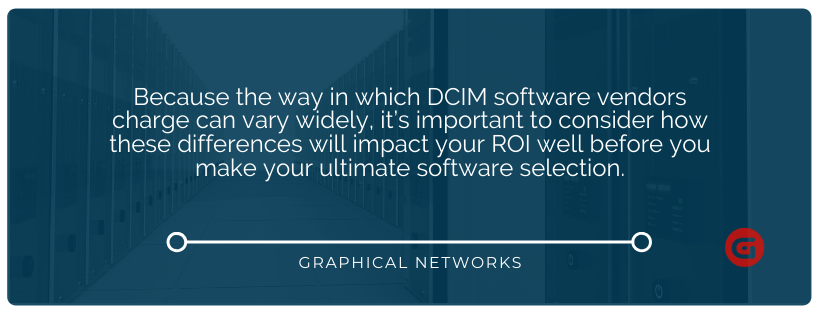
Your boss has tasked you to research procuring a DCIM software for your organization… after a series of exhaustive and endless meetings with different stakeholders to determine your set of requirements what you need from a DCIM solution should include from your department and colleagues, its time to finally start the search for DCIM vendors (make sure to view our series on choosing the right DCIM solution here).
After you’ve narrowed down your list of DCIM vendors to contact and you start looking into costs, it can get awfully confusing on how DCIM vendors price their solution!
How, exactly, is the software priced?
Because the way in which DCIM software vendors charge can vary widely, it’s important to consider how these differences will impact your ROI well before you make your ultimate software selection. For example, some vendors may charge per rack, or per floor mounted asset, per device, and even by IP Addresses. Some may charge for those and by number of users, as well. Need some tylenol, yet? This can be overwhelming for anyone.
Sorry, we aren’t done yet…
What’s included, what’s extra?
In addition to finding out what the pricing is based on, you’ll need to find out what’s actually included in the DCIM package and what will come with an additional price tag. For example: are there any additional modules, such as: discovery, real-time power monitoring, that will cost extra?
Make sure to ask your DCIM vendors, exactly what the pricing structure is, what exactly does that mean, and are there any other less-than-obvious costs that needs to be considered? An understanding of what you’re going to get, and for how much, is crucial when comparing apples to apples, DCIM vendor A with DCIM vendor B.
Yearly vs. perpetual licenses?
How is the software licensed? Licensing is another area that varies widely amongst DCIM vendors. Some software vendors may only sell the software with a yearly subscription that needs to be renewed annually. Some vendors may offer the software with a perpetual license. (perpetual license is the ‘old school’ way of selling on-premise software programs — it’s a one-time cost – which many venture capitalists (VC) and angel investors don’t like to see!) in which you can keep the license forever and usually has an associated software maintenance that may or may not be required. Annual software maintenance packages typically include new versions of the software in addition to ongoing technical support.
Nowadays, however, many software vendors sell only by yearly subscription-based licensing (it what the VC’s like to see). For the consumer, a yearly subscription has a much lower upfront costs (unlike a perpetual license). It must be renewed though, as it’s a timed license key (12, 24, or 36 month terms are the typical standard lengths for these limited licenses), in order to continue to use your DCIM software. Does there come a point in which your break-even is better for a perpetual license vs. a yearly subscription? Yes. Typically, what we have seen and even with our netTerrain DCIM solution, if you use your DCIM solution for more than three years, it is far better to choose a perpetual license.
When selecting your DCIM vendor which license approach do you like to have? Perpetual license or annual subscription license? Keep in mind that what is better for venture capital-funded DCIM vendors may not be best for you — read more about discerning the best long-term DCIM vendor for your needs here.
Cloud offering?
Many organizations today are moving toward the Cloud (AWS, Azure, etc.). Ask if the DCIM vendor also offer a Cloud instance in addition to on-premises. Further, find out if you can easily move from Cloud instance to an on-premise instance and have the data transferred to on-premise?
netTerrain DCIM pricing?
As we are DCIM vendors ourselves (netTerrain DCIM), you may be curious as to how our DCIM software is priced.
- Pricing structure: We try to keep it simple: netTerrain DCIM is priced by the number of objects you track. What the heck are objects? Objects are racks and devices inside the racks (devices are the physical chassis equipment, such as servers, routers, switches, patch panels, and PDU’s). netTerrain doesn’t charge for the subcomponents of the devices, such as: cards, ports, and its connections. For example a Blade chassis such as a Dell PowerEdge VRTX, counts as just one object!
- Extra costs to consider: What about real-time power monitoring? Is that extra? For 2020, netTerrain DCIM with its Environmental Monitoring Modules is now a standard feature in netTerrain DCIM! The only extra module in netTerrain is the Outside Plant Module and is needed if documenting the fiber strands inside and/or outside buildings. For more information on netTerrain OSP, click here.
- Licensing: netTerrain DCIM can be purchased with on-premise licensing (offering both perpetual and yearly subscription) or through its Cloud offering.
Bottom line? Once you’ve finalized a list of possible vendors for your organization’s DCIM software purchase, you need to find out what the costs are: how you’ll be charged, how often you’ll be charged, what you may need but isn’t included out-of-the-box, and any additional considerations before you sign on the dotted line. Comparing costs and pricing structures is as important to your DCIM implementation’s long-term success as the usability: after all, only that which is actually sustainable will last (and you can only sustain what you can afford).
